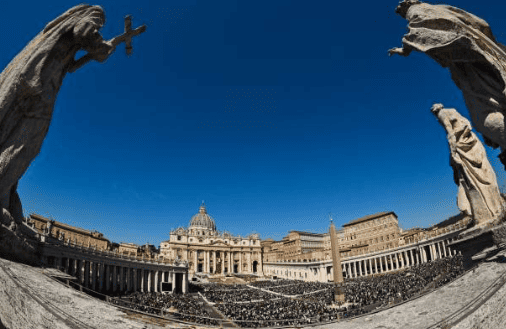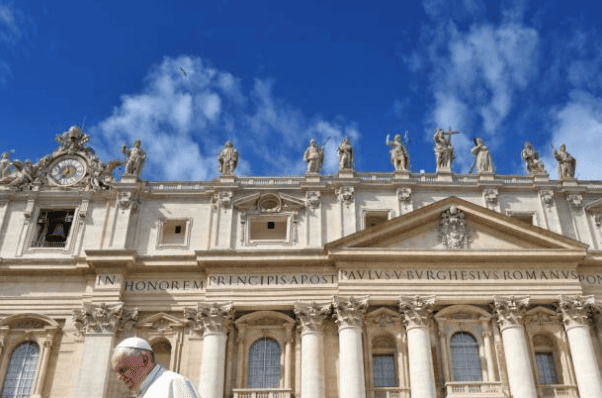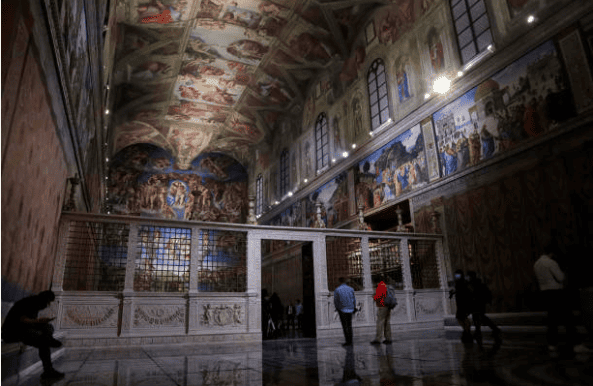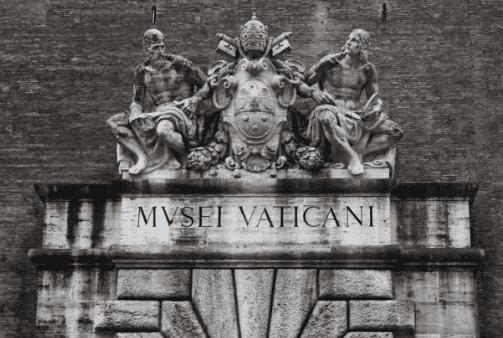I have to admit that half of my European trip happened because of my admiration for church architecture and art. Among all the churches I’ve visited, the Baroque and Renaissance styles of St. Peter’s Basilica in Vatican City were the most breathtaking.
“Let’s go. We’re not Catholic,” my Vietnamese friend said after we had wandered around St. Peter’s Basilica for a few hours. Honestly, I should’ve insisted on staying because I didn’t feel like I had fully explored every corner of the basilica, nor had I had the chance to appreciate each artwork. But since we were starving, we decided to head back to the entrance of Vatican City, grab the scooter, and roam around Rome looking for pizza for lunch. Still, those few hours in the Vatican left a deep impression on me. I’ve written about the grandeur of the Roman Catholic headquarters and the Pope’s residence in several publications, including here.
VATICAN TRIP: THE SMALLEST COUNTRY IN THE WORLD

That morning, amidst the hundreds of people gathered at Piazza di San Pietro (St. Peter’s Square), I found myself in awe, standing dumbfounded before the magnificent building that resembled a palace. After a while of being stunned, my friend and I decided to enter St. Peter’s Basilica. The line was already long even though we had started our Vatican trip early at 9 AM. Since the staff took time checking everyone’s bags, it took about an hour before I could finally enter the Pope’s residence.
Located in the heart of Rome, Vatican City is the smallest country in the world in both area and population. But the Vatican, as we know it today, was only established in the 20th century, specifically in 1929, through the Lateran Treaty between the Kingdom of Italy and the Holy See. Before that, the Vatican was part of the Papal States, which ruled over much of Europe for centuries until 1870. When Italy unified to become the Kingdom of Italy, the Vatican was untouched, except for some properties being confiscated, such as a few basilicas and the Quirinal Palace, which used to serve as the Pope’s residence but was turned into the royal palace.
Covering just 49 hectares, there are only a few buildings within Vatican territory, namely St. Peter’s Basilica, St. Peter’s Square, the Sistine Chapel, the Apostolic Palace, and the Vatican Museums. Apart from this, the Vatican, which has only 825 residents, also owns some properties within Italian territory, including major basilicas and the Pope’s palace at Castel Gandolfo, a small town outside Rome known for its stunning views of Lake Albano.
VATICAN TRIP: HOW TO GET THERE

If you’re planning a trip to Vatican City, the first step is to get to Rome. From Paris, I took an EasyJet flight that took 2 hours to Fiumicino Airport in Rome. After that, I continued with an airport bus to Termini station. Since I was traveling with a friend who lives in Rome, I didn’t need to use public transportation—we just used a scooter. But if you’re planning to use public transport during your Vatican trip, you can take metro line A and get off at Ottaviano station, or take bus 40 or 64, hop on a tour bus, or simply walk. The Vatican, located in the northern part of central Rome, can be reached on foot within 15-20 minutes from Piazza Navona in the city center. Once you arrive in the Vatican area, you can explore every corner on foot. There’s no need for any additional transport, as the territory is small.
VATICAN TRIP: THINGS TO SEE & DO
1. St. Peter’s Basilica

A visit to the Vatican is a must when in Rome. The main attraction in the Vatican is, of course, the grand and opulent St. Peter’s Basilica. I spent an hour in the square (St. Peter’s Square) just soaking in the beauty of this palace-like church (though part of the time was due to the line).
St. Peter’s Basilica is one of the largest churches in the world and one of the holiest in Christianity. It’s where the Pope leads many liturgies throughout the year. This Renaissance and Baroque-style basilica is famous for the contributions of world-renowned artists who helped build and adorn it. Notable names include Michelangelo, Raphael, and Gian Lorenzo Bernini.
The Basilica was built in 1506 after the previous church was demolished. Construction was completed in 1626. The basilica is named after Saint Peter, one of Jesus’ 12 disciples, who is believed to have been buried here after his execution in Rome. Bernini created St. Peter’s Baldachin, a Baroque-style bronze canopy placed directly under the basilica’s dome to mark the location of Saint Peter’s tomb beneath it.
Other must-see artworks inside the basilica, whether you’re Catholic or not, include Michelangelo’s Pietà and the statue of Saint Peter on his throne. Don’t miss the chance to see the Vatican and the city of Rome from the top of St. Peter’s Basilica’s dome during your Vatican trip. The dome itself is awe-inspiring, both from a distance and up close. Its grandeur has inspired many buildings and churches worldwide, such as The Capitol in Washington, D.C., USA, and St. Paul’s Cathedral in London, UK.
Entry to St. Peter’s Basilica is free. However, to climb to the top of the dome, tickets cost 6 euros (with 551 steps) or 8 euros (with an elevator ride followed by 320 steps). Be sure to visit before 9 AM to avoid long queues.
2. St. Peter’s Square

One of the most breathtaking squares in the world. St. Peter’s Square was designed by Bernini with the support of Pope Alexander II between 1656 and 1667. This is where Vatican events are held, as the square can accommodate over 300,000 people.
One of the most striking features of St. Peter’s Square is the 284 columns built by Bernini on either side of the basilica. Atop these columns stand 140 statues of saints, created by Bernini’s students. In the center of the square stands the Obelisk, brought to Rome from Egypt in 1586. Nearby are two fountains by Bernini and Carlo Maderno.
St. Peter’s Square can be visited free of charge.
3. Sistine Chapel

This is where Michelangelo’s masterpiece, The Creation of Adam and The Last Judgement, are located. The Sistine Chapel is often considered one of the greatest treasures of Vatican City and Rome, and it’s something you must see at least once in your lifetime. It’s not the architecture but the stunning decoration that makes it so remarkable. The walls and ceiling of the Sistine Chapel are covered in frescoes (wall paintings). Michelangelo himself painted the ceiling and dome, a task that took him four years.
The Creation of Adam, which depicts God giving life to Adam, can be found in the center of the dome. The Last Judgement, representing the Apocalypse of St. John, can be seen above the high altar.
To visit the Sistine Chapel during your trip to the Vatican, you must first enter the Vatican Museums. The ticket costs 16 Euros per person. To save money, you can visit on the last Sunday of each month when entry is free.
4. Vatican Museums

One of the largest museums in the world and among the most popular attractions in Rome, the Vatican Museums draw around 6 million visitors each year. A major reason for this is the Sistine Chapel, where many come to admire Michelangelo’s masterpiece. To visit the Sistine Chapel, you must enter through the Vatican Museums.
The Vatican Museums’ appeal lies in their vast collection of art and historical artifacts. During your trip to the Vatican, you’ll find statues and sarcophagi from Egypt, art from Greece, as well as pieces from Tibet and Indonesia. The museum is so large that it’s impossible to see everything in a single day. It’s best to focus on a few specific collections that interest you. The Vatican Museums are divided into several themed museums, including the Pio-Clementino Museum, the Egyptian Museum, the Etruscan Museum, the Ethnological Missionary Museum, the Raphael Rooms, the Borgia Apartment, the Pinacoteca, and more.
Because of its popularity, the Vatican Museums are always crowded with tourists. Visit in the morning or around 1 PM on weekdays. If you want to enjoy the museums without the crowds, avoid weekends, Holy Week, or the last Sunday of each month when admission is free but the crowds are huge.
The ticket for the Vatican Museums is 16 Euros (which includes access to the Sistine Chapel). Purchase your tickets online to avoid long lines. You can also join a guided tour to skip the line. Some tour packages even include access to the Vatican Gardens or Castel Gandolfo.
The Vatican was the first attraction I visited in Rome, and it’s one of the reasons I love the city so much. Unfortunately, I only had a few hours to enjoy the incredible artworks during my trip. Sadly, the current situation doesn’t allow for travel, but while waiting for another opportunity to visit the Vatican and explore Italy, let’s rewatch Angels and Demons on Netflix!
